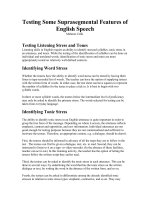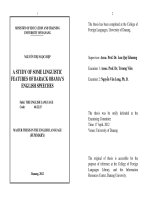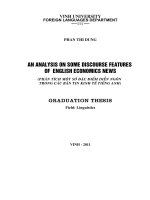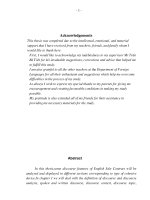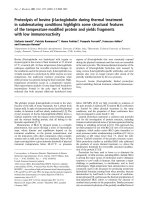Testing Some Suprasegmental Features of English Speech
Bạn đang xem bản rút gọn của tài liệu. Xem và tải ngay bản đầy đủ của tài liệu tại đây (52.05 KB, 2 trang )
Testing Some Suprasegmental Features of
English Speech
Mehmet Celik
Testing Listening Stress and Tones
Listening skills in English require an ability to identify stressed syllables, tonic stress in an
utterance, and tones. While the testing of the identification of syllables can be done on
individual and unrelated words, identification of tonic stress and tones are more
appropriately tested on relatively well defined contexts.
Identifying Word Stress
Whether the testees have the ability to identify word stress can be tested by having them
listen to tape-recorded list of words. The teacher can have the option of supplying testees
with the written form of words. In either case, the test sheet can have squares to represent
the number of syllables for the testee to place a tick in. It is best to begin with two syllable
words.
In three or more syllable words, the testees below the intermediate level of proficiency may
only be asked to identify the primary stress. The words selected for testing can be taken
from everyday language.
Identifying Tonic Stress
The ability to identify tonic stress in an English utterance is quite important in order to
grasp the true force of the message. Depending on where it occurs, the utterance reflects
emphasis, contrast and opposition, and new information. Individual utterances are not good
enough for testing purposes because they are not contextualised and sufficient to motivate
the testees. Therefore, an appropriate context, e.g. a dialogue, should be drawn'.
First, the testees should be informed in advance of all the steps they are to follow in the test
. The testees can first be given a dialogue, text, etc. to read. Second, they can be instructed
to listen to it on a tape- or video-recorder. (In the absence of these facilities, teacher can act
it out.) In this listening activity, the teacher has the option of letting the testees follow the
written script they earlier read.
Third, the testees can be asked to identify the tonic stress in each utterance. This can be
done in several ways: by underlining the word that has the tonic stress on the written
dialogue or text, by writing the word in the absence of the written form, and so on.
Fourth, the testees can be asked to differentiate among the already identified tonic stresses
in relation to tonic stress types: emphatic, contrastive, and so on. They may indicate each
type of tonic stress respectively on a piece of paper by using certain notations such as using
capital letters. For instance, T for unmarked tonic stress, E for emphatic stress, C for
contrastive stress, and N for new information stress.
Identifying Tones
First, a dialogue or a text having different but preferably the most frequently occurring
tones in daily conversations in English can be given to the testees to read, taking notice of
the punctuation marks for each sentence. Second, they are asked to listen to it. Third, they
should be informed that this time they have to assign a tone type to each utterance on a
piece of paper by using appropriate arrows, by other simpler notations so that it will not
take the testee to lose so much time in moving from one utterance to the next. Further, turn
takings in dialogues may be indicated on the sheet using (A) for speaker A and (B) for
speaker B, etc.
Summary
In testing listening skills, written tests can introduce the testee to the context of the test
material, and as such it triggers a better performance by the testee on the actual listening
performance. For listening testing, an audio tape (or video-tape if necessary for visual
purposes) can be used. Where these facilities are not available, the tester himself/herself
can read the test material. Appropriate notations, that is, ones that do not hinder the
movement of the testee from one testing item to the next, should be devised. Rather than
individual sentences or utterances, compact and meaningful contexts should be selected for
testing listening skills communicatively.

